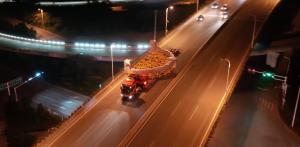Image of the week
On the thruway from Hefei to Shanghai
9 Sep 2019
Over the next four years, China will be shipping approximately 100 large components for the magnet feeder system, adding up to 1,600 tonnes of equipment in all. Two "Highly Exceptional Loads" left Shanghai in early August.
In the first leg of their voyage, in-cryostat feeders are transported by road between the manufacturing site (Hefei KEYE Electro Physical Equipment Manufacturing) and the port of Shanghai. Transport was managed by ITER logistics provider DAHER and local agent COSCO.
Feeder assembly is one of the major machine assembly activities, representing just over 11 percent of the total Tokamak machine baseline workload.
Thirty-one magnet feeders, distributed either under the machine or over the machine, will transport electrical power and cryogens in to the superconducting central solenoid, toroidal and poloidal field coils, and correction coils.
Measuring from 30 to 50 metres in length, the feeders are manufactured and shipped in three fully instrumented segments: the coil termination box (furthest from the machine), the cryostat feedthrough (the part of the feeder that passes through the bioshield and cryostat into the vacuum environment) and the in-cryostat feeder (which connects to the coils).
The in-cryostat feeders sent in August by China have a unique semi-circular shape due to their assembly position under the vacuum vessel inside of the cryostat base. They will connect to the bottom correction coils, and need to be on site relatively early in the assembly sequence.
The components will travel this month along the ITER Itinerary as "Highly Exceptional Loads.*"
*About 10,000 ITER components fall into the category of "Conventional Loads," 3,000 are "Conventional Exceptional Loads" and 300 are "Highly Exceptional Loads."


